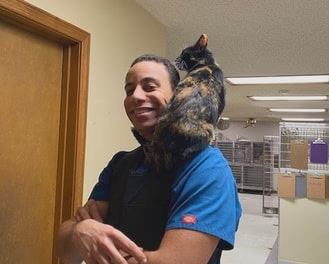8 Min Read
What Is Hip Dysplasia In Dogs?
Key takeaway

Why pet owners are switching to online vet care with Dutch
-
Prescriptions delivered free to you
-
Fast access to Licensed Vets over video
-
Unlimited video visits and follow-ups
Hip dysplasia is a medical condition that affects the growth and development of the hip joint. Because the hip joint is such an important joint for movement, hip dysplasia in dogs can affect their walking ability and cause significant pain. This condition is more common in larger dogs, but it can impact breeds of all sizes. If your dog is limping and showing signs of pain, it’s a good idea to have them checked for hip dysplasia.
The hip joint acts as a ball and socket. Typically, this ball can move freely in the socket, which is what allows your hips to move. With hip dysplasia, however, the ball and socket grind together instead of sliding smoothly, causing damage to the hip joint.1
Over time, hip dysplasia will continue to deteriorate the hip joint, eventually leading to a total loss of functionality if left untreated. Because the symptoms of hip dysplasia are similar to the symptoms of dog arthritis, pet parents and vets may not recognize hip dysplasia in dogs until it has taken a toll. If you want to keep your dog healthy and moving around, here’s what you need to know about canine hip dysplasia.
- Signs of Hip Dysplasia in Dogs
- Causes of Hip Dysplasia in Dogs
- Diagnosing Hip Dysplasia
- Hip Dysplasia Dog Treatment
- Minimizing Your Dog’s Risk for Hip Dysplasia
- Canine Hip Dysplasia: Frequently Asked Questions
- Final Notes

Signs of Hip Dysplasia in Dogs
As a pet parent, looking out for signs of hip dysplasia and other medical conditions can help keep your dog healthy for longer. You may even be able to prevent dog arthritis if you spot the symptoms early enough. When it comes to hip dysplasia in dogs, some of the symptoms you should keep an eye out for include:
- Limping
- Pain
- Stiffness
- Decreased range of motion and activity
- “Bunny hopping” gait
- Difficulty jumping, running, or climbing
- Muscle loss in thighs
- Larger shoulder muscles
Keep in mind that some of these symptoms can also be due to a traumatic injury or arthritis. If you notice several of these warning signs in your pooch, take them to the vet to get an expert’s opinion. A vet will be able to provide you with information on whether hip dysplasia is present and suitable treatment options.
Causes of Hip Dysplasia in Dogs
Understanding the causes of hip dysplasia in dogs can help you prevent it. So, what is hip dysplasia in dogs caused by? There are several factors that can result in hip dysplasia2, including:
- Weight—Dogs who are overweight or exercise in ways that put extra stress on their joints are at a higher risk for hip dysplasia. It’s important to keep your dog at a healthy weight to minimize health problems, but you don’t want them running and jumping around so much that they’re damaging their joints.
- Age—Age can also be a determining factor in hip dysplasia in dogs. The signs of hip dysplasia usually become apparent when your dog is younger, with symptoms typically showing around 1 to 2 years old. As the hip joint deteriorates over time, your dog’s symptoms may worsen with age.
- Genetics—Genetics is a critical factor when it comes to hip dysplasia in dogs. Certain dog breeds, especially larger breeds, are more prone to hip dysplasia and other joint-related conditions. Some of the dog breeds that commonly develop hip dysplasia include Great Danes, St. Bernards, and German Shepherds.

Dog breeds susceptible to hip dysplasia
Similar to how certain dogs may be prone to dog anxiety, some breeds are more susceptible to hip dysplasia than others. Large dog breeds are particularly prone to hip dysplasia because their weight puts a lot of stress on their joints. Here are some of the breeds that are more likely to develop hip dysplasia3:
- Labrador Retriever
- German Shepherd
- Rottweiler
- Poodle
- Great Dane
- St. Bernard
If your dog is one of the breeds mentioned above, you should talk to your vet about the steps you can take to minimize hip dysplasia. Making sure your dog gets plenty of moderate exercise and eats a healthy diet is a great start to keeping them in good shape.
Diagnosing Hip Dysplasia
With hip dysplasia in dogs, getting a diagnosis early on is essential. The sooner you diagnose hip dysplasia and start treating it, the more you can do to slow down the deterioration of the hip joint.
Diagnosing hip dysplasia starts with a physical exam. In some cases, a physical exam alone is enough to diagnose hip dysplasia. It’s also important to let your vet know about any symptoms or discomfort your dog is experiencing. Your vet may also use bloodwork to see if your dog is experiencing inflammation as a result of joint disease. Depending on how your vet diagnoses hip dysplasia, your dog may need light sedation during their exam.
For younger dogs, the PennHIP is an effective way to determine if a puppy will develop hip dysplasia4. Using the PennHIP method to diagnose hip dysplasia early on means you can start focusing on surgery and other treatment options to reduce the damage caused by the disease.

Hip Dysplasia Dog Treatment
Your vet will typically recommend a combination of treatments for hip dysplasia. For example, they may need physical therapy or exercise less, or they’ll need to lose some weight and take medication. Ultimately, the best treatment option depends on your dog’s condition and medical history.
Losing weight can do a lot to lessen the effects of hip dysplasia since joint deterioration can happen faster in larger dogs. So, reducing the amount of weight your dog puts on their joints can ease their pain and minimize hip joint damage.1 Your vet may even recommend switching to specialized dog food for weight loss.
If your dog has a bouncing gait or likes to leap from high distances, restricting these activities can also help with hip dysplasia. You may need to talk to your vet about physical therapy to change how your dog walks and runs if they tend to bounce during these activities.
When at-home treatments like weight reduction and exercise restrictions don’t help, medication is also an option. Your vet may recommend medication with other treatment options to reduce pain caused by hip dysplasia.
Hip dysplasia surgery
In some cases, surgery is the best treatment option for hip dysplasia. However, complications can arise depending on the surgery your dog gets, so it’s essential to talk with your vet about your options and determine what’s best for your dog. Here are some of the surgeries used to treat hip dysplasia1:
- Double or triple pelvic osteotomy (DPO/TPO)
- Femoral head ostectomy (FHO)
- Total hip replacement (THR)
DPO/TPO is typically used to treat hip dysplasia in puppies, thus improving the function of the joint by cutting the bone and moving the pieces into place.
FHO involves cutting off the “ball” portion of the bone that goes into the hip socket, which leads to the creation of another joint. While FHO can relieve pain caused by hip dysplasia, it doesn’t fully restore hip function.
Total hip replacement (THR) is generally considered the most effective surgery for hip dysplasia in dogs. A surgeon will implant an artificial hip joint to relieve the pain and discomfort caused by hip dysplasia. Like any surgery, there are potential complications with THR.
Minimizing Your Dog’s Risk For Hip Dysplasia
As a pet parent, it’s up to you to do what you can to keep your pets healthy. If your dog is one of the breeds susceptible to hip dysplasia, you should talk to your vet about minimizing your dog’s risk for hip dysplasia.
Choosing puppy food that’s formulated for large breeds is also a good start. This dog food helps manage growth, so your dog doesn’t develop skeletal disorders as they grow. Taking your dog to the vet for regular exams is also recommended since it allows you to spot medical problems early on. Knowing what hip dysplasia is can also make it easier to identify the warning signs of this disease before it takes a toll on your dog’s health.

Canine Hip Dysplasia: Frequently Asked Questions
What are the signs of hip dysplasia in dogs?
If your dog has hip dysplasia, you may notice limping, pain, stiffness, and difficulty running, jumping, or climbing. Some dogs with hip dysplasia may also have large shoulder muscles and begin losing muscle mass in their thighs. If your pup is in pain and experiencing several signs of hip dysplasia, talk to a vet or schedule an appointment to get a diagnosis.
How long can a dog live with hip dysplasia?
The good news about hip dysplasia is that dogs can continue to live a long, happy life. If you think your dog may have hip dysplasia, taking them to the vet for a diagnosis as soon as you can is vital. Once your dog has been diagnosed, make sure you talk to your vet about potential treatment options, including medication and surgery. With the right treatment, dogs with hip dysplasia can live a long life with minimal pain and discomfort.1
Is dog hip dysplasia curable?
Dog hip dysplasia can be cured, but it can only be cured through surgery. While surgery may not be the most common hip dysplasia dog treatment, it’s an option if your dog has severe hip dysplasia. Total hip replacement is generally considered the most effective surgical treatment for hip dysplasia in dogs, though there are possible complications to consider.
Final Notes
Hip dysplasia in dogs isn’t the most common medical condition, but every pet parent should know about it. Watching for the signs of hip dysplasia in dogs is especially important if you have a large dog or a dog who’s overweight. Treatment for hip dysplasia can include weight loss, dog prescription medication, and surgery. If your dog is having trouble getting around due to hip dysplasia, it’s crucial to get them the help they need right away.
To help your dog live a healthy life, Dutch makes it easy to speak with a vet from the comfort of your home with our telemedicine service for pets. Simply schedule an appointment with a vet and video chat with them to get expert advice for several health issues, including anxiety and allergies.
Share
References
-
Parnell. “Hip Dysplasia In Dogs.” American Kennel Club, American Kennel Club, 21 July 2021, https://www.akc.org/expert-advice/health/hip-dysplasia-in-dogs/.
-
“Developmental Orthopedic Disease: What Is Hip Dysplasia?” Canine Arthritis Resources and Education, 14 Apr. 2020, https://caninearthritis.org/article/dod-hip-dyplasia/.
-
“Breed Statistics: Orthopedic Foundation for Animals.” Orthopedic Foundation for Animals, 4 May 2020, https://www.ofa.org/diseases/breed-statistics.
-
“Canine Hip Dysplasia.” ACVS, American College of Veterinary Surgeon, https://www.acvs.org/small-animal/canine-hip-dysplasia.



